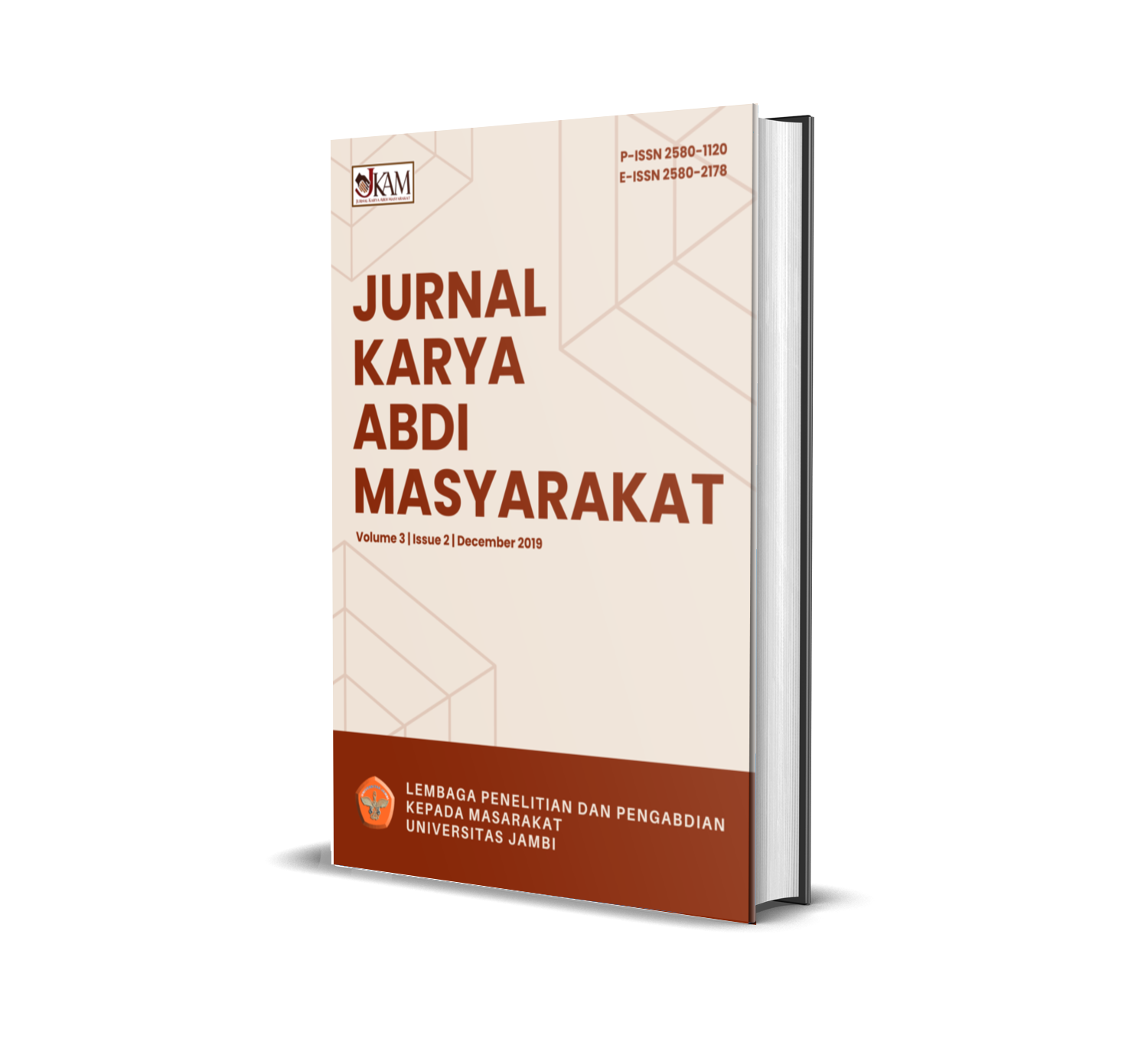Pelatihan Pembuatan Herbarium Sebagai Media Pembelajaran Biologi di SMAN 11 Muaro Jambi
DOI:
https://doi.org/10.22437/jkam.v3i2.8479Abstract
Salah satu mata pelajaran yang diajarkan di Sekolah Menengah Tingkat Atas adalah Biologi. Biologi mempunyai karakteristik berupaya untuk mengenal mahluk hidup dan proses kehidupannya di lingkungan, sehingga memerlukan pendekatan dan metode yang memberi ciri dan dasar kerja dalam pengembangan konsep. Untuk itu diperlukan pendekatan dan metode yang memberi ciri dan dasar kerja dalam pengembangan konsep. Salah satu upaya untuk pengembangan konsep adalah penggunaan media pembelajaran. Salah satu media yang dapat digunakan dalam pembelajaran biologi terutama untuk materi klasifikasi makhluk hidup adalah herbarium. Herbarium merupakan media pembelajaran yang praktis dan ekonomis, karena dapat digunakan, baik di kelas maupun di laboratorium. Hal ini akan mengatasi alokasi waktu pembelajaran yang terbatas dan keselamatan siswa bisa diantisipasi dibandingkan apabila pelaksanaannya siswa langsung diterjunkan ke lapangan.
Tujuan dari kegiatan pengabdian ini adalah memanfaatkan tumbuhan yang ada disekitar sekolah menjadi media pembelajaran berupa Herbarium. Metode yang digunakan dalam kegiatan pengabdian ini adalah ceramah, diskusi dan praktek. Pelaksanaan kegiatan pengabdian yang dilakukan meliputi: pengurusan izin administrasi , mempersiapkan bahan dan alat, serta pembuatan herbarium. Pelaksanaan pengabdian dilaksanakan pada tanggal 14 Agustus 2018. Pelatihan diikuti 32 orang. Pelatihan diawali dengan pemberian materi tentang media pembelajaran khususnya herbarium mengunakan ppt dan video. Selanjutnya para peserta membuat herbarium. Pembuatan herbarium diawali dengan koleksi sampel tumbuhan yang ada di sekitar sekolahan, selanjutnya dilakukan pengepresan dan pengeringan menggunakan sinar matahari, setelah specimen kering selanjutnya di lakukan penempelan dan pemberian label. Secara umum pelatihan berjalan lancar dan peserta menjadi paham tentang pembuataan herbarium dan dapat menggunakan nya sebagai media pembelajaran.
Downloads
References
2. Antou, D., A Arrijani & D.F Pendong. 2013. Penggunaan Media Herbarium Pada Pembelajaran Klasifikasi Tumbuhan dalamMeningkatkan Hasil Belajar Siswa di SMP Advent Ratahan. Jurnal SME MIPA UNIMA 1(10)
3. Kustandi, C. dan Bambang, S. 2011. Media Pembelajaran. Bogor: Ghalia.
4. Hasugian, H. & Napitupulu, M.A 2016. Perbedaaan Hasil Belajar Spermatophyta Siswa yang diajar Menggunakan Media Herbarium dan Tanpa Media Herbarium Di Kelas X SMA Negeri 2 Kisaran. Jurnal Pelita Pendidikan 4 (.3) 040 – 044
5. Majid, D. dan Sunarti, M. 2013 Pengembangan Media Pembelajaran Herbarium Pada Siswa Madrasah Aliyah Kota Ternate. Jurnal ßioêdukasi 2(1): 196.
6. Sadiman, A.S. 2000. Media Pendidikan. Jakarta: Raja Grafindo
7. Sulistyarsi, A. 2010. Penggunaan Media Herbarium dan Insectarium dalam Pembelajaran Biologi Untuk Meningkatkan Hasil Belajar Siswa. Jurnal Pendidikan MIPA. Vol 2, Nomor 1.
8. Tjitrosoepomo, G. 2009. Taksonomi Umum. Yogyakarta: Gadjah MadaUniversity Press.
Downloads
Published
Versions
- 2019-12-31 (1)
- 2019-12-31 (1)
How to Cite
Issue
Section
License
Please find the rights and licenses in Jurnal Jurnal Karya Abdi Masyarakat (JKAM).
- License
The non-commercial use of the article will be governed by the Creative Commons Attribution license as currently displayed on Creative Commons Attribution 4.0 International License.
- Authors Warranties
The author warrants that the article is original, written by stated author(s), has not been published before, contains no unlawful statements, does not infringe the rights of others, is subject to copyright that is vested exclusively in the author and free of any third party rights, and that any necessary written permissions to quote from other sources have been obtained by the author(s).
- User Rights
JKAM's spirit is to disseminate articles published are as free as possible. Under the Creative Commons license, JKAM permits users to copy, distribute, display, and perform the work for non-commercial purposes only. Users will also need to attribute authors and JKAM on distributing works in the journal.
- Rights of Authors
Authors retain the following rights:
- Copyright, and other proprietary rights relating to the article, such as patent rights,
- The right to use the substance of the article in future own works, including lectures and books,
- The right to reproduce the article for own purposes, provided the copies are not offered for sale,
- The right to self-archive the article.
- Co-Authorship
If the article was jointly prepared by other authors, the signatory of this form warrants that he/she has been authorized by all co-authors to sign this agreement on their behalf, and agrees to inform his/her co-authors of the terms of this agreement.
- Termination
This agreement can be terminated by the author or JKAM upon two months notice where the other party has materially breached this agreement and failed to remedy such breach within a month of being given the terminating party notice requesting such breach to be remedied. No breach or violation of this agreement will cause this agreement or any license granted in it to terminate automatically or affect the definition of JKAM.
- Royalties
This agreement entitles the author to no royalties or other fees. To such extent as legally permissible, the author waives his or her right to collect royalties relative to the article in respect of any use of the article by JKAM or its sublicensee.
- Miscellaneous
JKAM will publish the article (or have it published) in the journal if the articles editorial process is successfully completed and JKAM or its sublicensee has become obligated to have the article published. JKAM may conform the article to a style of punctuation, spelling, capitalization, referencing and usage that it deems appropriate. The author acknowledges that the article may be published so that it will be publicly accessible and such access will be free of charge for the readers.














